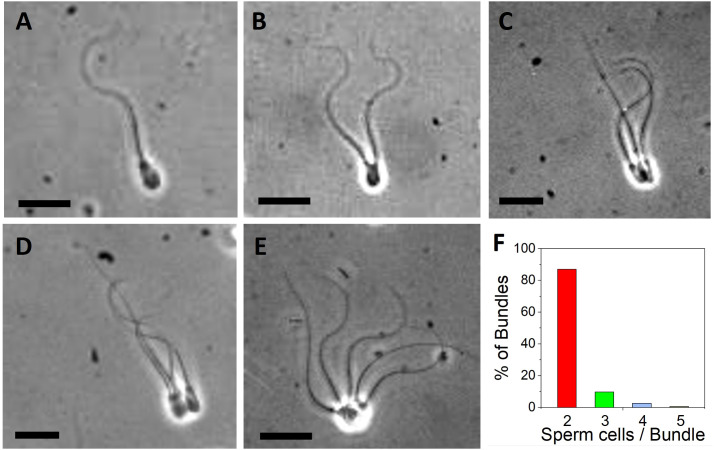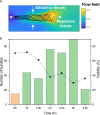Bundle formation of sperm: Influence of environmental factors

original article was Published online: October 10, 2022
(https://pubmed.ncbi.nlm.nih.gov/36299459/)
written by Paula Morcillo I Soler, Carlos Hidalgo, Zoltán Fekete, Laszlo Zalanyi , Islam S M Khalil, Marc Yeste , Veronika Magdanz
Abstract
Cooperative behaviour of sperm is one of the mechanisms that plays a role in sperm competition. It has been observed in several species that spermatozoa interact with each other to form agglomerates or bundles. In this study, we investigate the effect of physical and biochemical factors that will most likely promote bundle formation in bull sperm. These factors include fluid viscosity, swim-up process, post-thaw incubation time and media additives which promote capacitation. While viscosity does not seem to influence the degree of sperm bundling, swim-up, post-thaw migration time and suppressed capacitation increase the occurrence of sperm bundles. This leads to the conclusion that sperm bundling is a result of hydrodynamic and adhesive interactions between the cells which occurs frequently during prolonged incubation times.
Keywords: bundling; cell-cell interaction; cooperative behaviour; sperm competition; sperm migration; sperm selection; spermatozoa.
Conflict of interest statement
Authors ZF and LZ were employed by ONGO Vettech Ltd. The remaining authors declare that the research was conducted in the absence of any commercial or financial relationships that could be construed as a potential conflict of interest.

Figure 1 Images of bovine sperm bundles obtained from videomicroscopy. (A) Single sperm cell. Bundle with (B) 2 cells (C) 3 cells (D) 4 cells (E) 5 cells. Video 1–4 show representative cases. Scale bars are 20 µm. (F) Distribution of observed bundles depending on the number of sperm cells per bundle (2, 3, 4 and 5 cells per bundle).

Figure 2 Occurrence of cell bundles as percentage of total number of bull sperm before and after swim-up in different levels of viscosity (different concentrations of methyl cellulose). Viscosities are average values at shear rate 100 1/s. (A) DMEM (B) DMEM medium + BSA medium.

Figure 3 (A) Schematic of flow fields around a sperm cell, from head (left) to tail (right), displaying the attractive and repulsive forces. (B) Total number of cell bundles of bull sperm over post-thaw migration time. 0h shows before swim-up sperm at 0h time (orange), 1 to 3.5h refers to swim-up sperm (green). On the right y-axis is the overall viability plotted, obtained from fluorescent staining at the different time points.

Figure 4 Velocities of bundles of bull sperm depending on cell number per bundle in different levels of viscosity. A total of 136 sperm cells were studied at 0%, 116 at 0.1%, 138 at 0.2%. 137 at 0.4% and 135 at 0.6%, a total amount of 662 sperm cells were studied.

Figure 5 Investigation of amount of capacitated sperm over post-thawing incubation time. Flow cytometry results of Fluo-3 stained bull sperm at different post-thaw incubation times after swim-up in (A) DMEM (B) DMEM + BSA. (C) CTC assay results of sperm bundles showing the % of bundled sperm displaying the F pattern (non-capacitated), B pattern (capacitated, acrosome intact) or AR pattern (acrosome reacted).
References
- Eisenbach M, Giojalas LC. Sperm guidance in mammals — an unpaved road to the egg. Nat Rev Mol Cell Biol (2006) 7:276–85. doi: 10.1038/nrm1893 - DOI - PubMed
- Burnett WE, Heinze J. Sperm bundles in the seminal vesicles of sexually mature lasius ant males. PloS One (2014) 9:e93383. doi: 10.1371/journal.pone.0093383 - DOI - PMC - PubMed
- Sasakawa K. Sperm bundle and reproductive organs of carabid beetles tribe pterostichini (Coleoptera: Carabidae). Naturwissenschaften (2007) 94:384–91. doi: 10.1007/s00114-006-0200-4 - DOI - PubMed
- Fisher HS, Hoekstra HE. Competition drives cooperation among closely related sperm of deer mice. Nature (2010) 463:801–3. doi: 10.1038/nature08736 - DOI - PMC - PubMed
- Pizzari T, Foster KR. Sperm sociality: cooperation, altruism, and spite. PloS Biol (2008) 6:e130. doi: 10.1371/journal.pbio.0060130 - DOI - PMC - PubMed